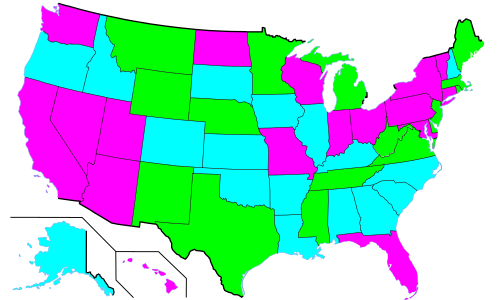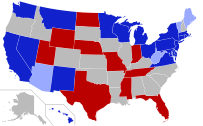| This article is part of a series on the |
| United States Senate |
|---|
 |
| History of the United States Senate |
| Members |
|
|
| Politics and procedure |
| Places |
The 100 seats in the United States Senate are divided into 3 classes to determine which seats will be up for election in any 2-year cycle, with only 1 class being up for election at a time. With senators being elected to fixed terms of 6 years, the classes allow about a third of the seats to be up for election in any presidential or midterm election year instead of having all 100 be up for election at the same time every six years. The seats are also divided in a way that any given state's 2 senators are in different classes so that each seat's term ends in different years. Class 1 and class 2 consist of 33 seats each, while class 3 consists of 34 seats. Elections for class 1 seats are scheduled to take place in 2024, class 2 in 2026, and the elections for class 3 seats in 2028.
The 3 classes were established by Article I, Section 3, Clause 2 of the U.S. Constitution. The actual division was originally performed by the Senate of the 1st Congress in May 1789 by lot.[1] Whenever a new state subsequently joined the union, its two Senate seats were assigned to two different classes by a random draw, while keeping the three classes as close to the same number as possible.[2]
The classes only apply to the regular fixed-term elections of the Senate. A special election to fill a vacancy, usually either due to the incumbent resigning or dying while in office, may happen in any given year regardless of the seat's class.[3]
A senator's description as junior or senior senator is also not related to their class. Rather, a state's senior U.S. senator is the one with the greater seniority in the Senate, which is mostly based on length of service.



